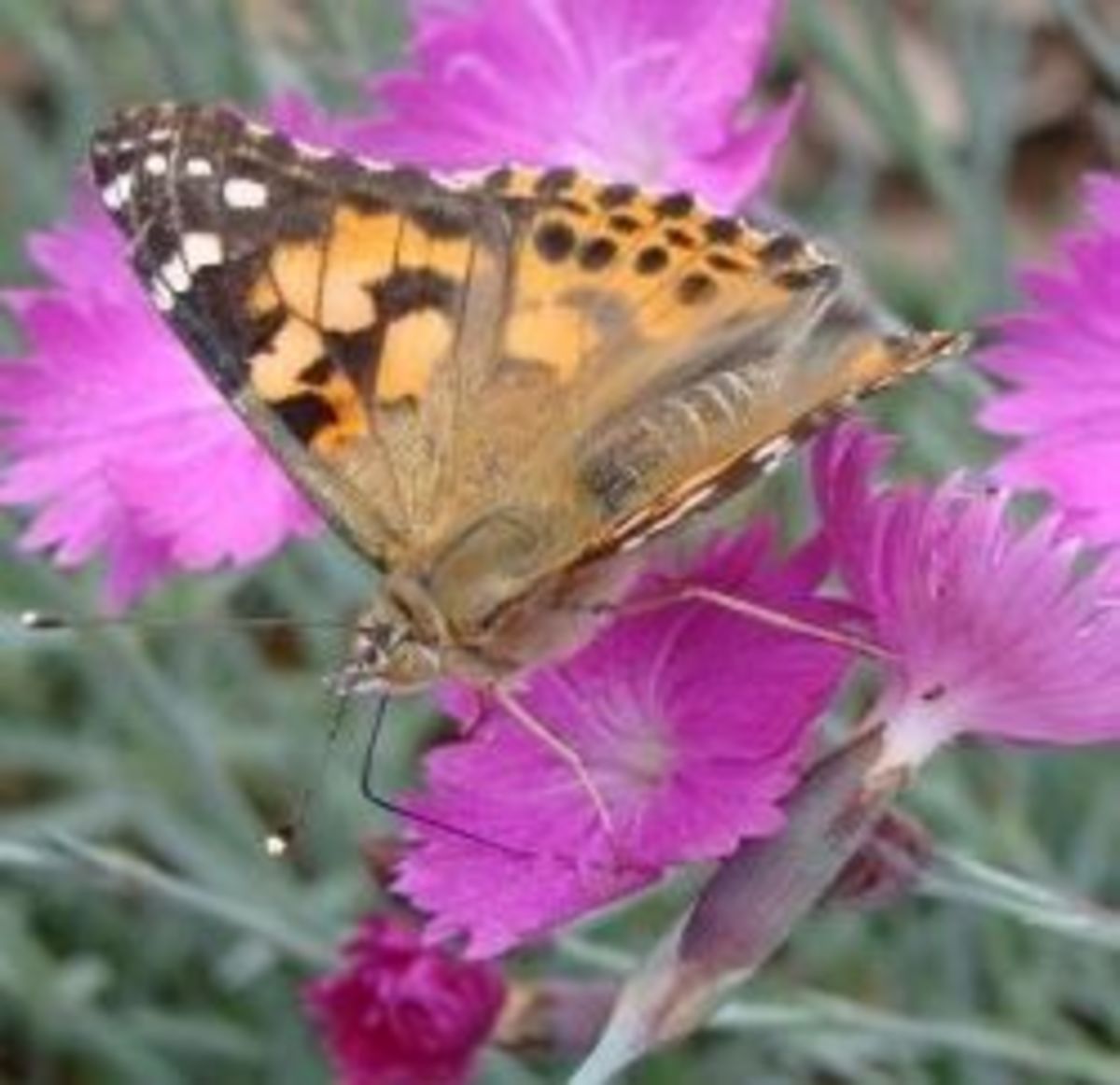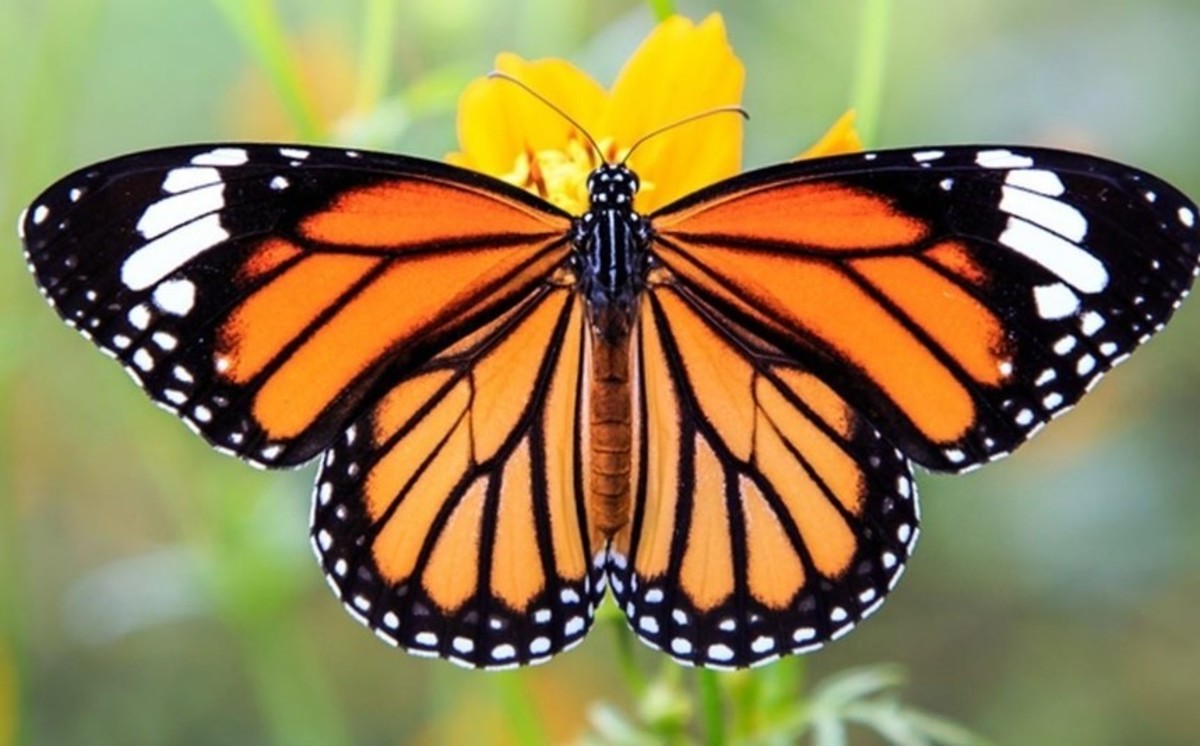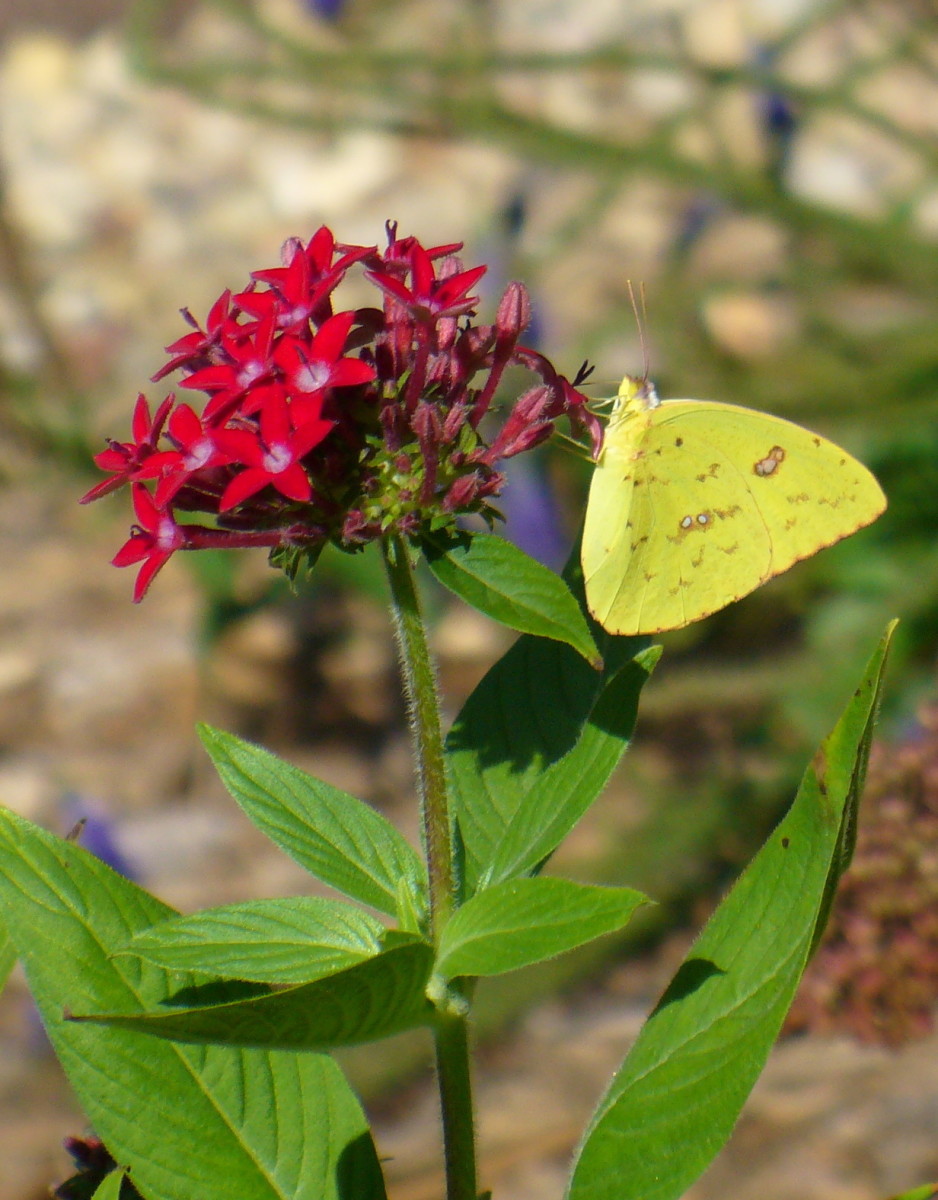- HubPages»
- Education and Science»
- Life Sciences»
- Entomology»
- Insects & Bugs
Canary Islands butterfly gardening in Tenerife
How to attract butterflies
Just like everywhere else in the world, here in Tenerife in the Canary Islands, everyone loves to see pretty butterflies flying around in the sunshine, and there are ways of attracting them to your garden and helping them too. If you don't have a garden you can still get the winged insects coming to a balcony or terrace if you have the right plants and flowers there.
Butterflies need flowers to feed from as adults and food plants for their caterpillars. Many species have only a few plants that their larvae will eat. Some people think that caterpillars eat leaves and that all sorts of leaves will do but sadly this is rarely the case. Most types of caterpillar need specific plants.
So there are two ways of attracting adult butterflies: you can grow flowers that will provide them with nectar, and equally important, you can cultivate plants they can lay their eggs on and which will provide a home for their caterpillars.
In Tenerife and the Canary Islands, the most spectacular butterfly is the Monarch (Danaus plexippus). The numbers of these magnificent insects that we see about is directly related to how many people and in how many places their food plants grow.
Monarch butterfly
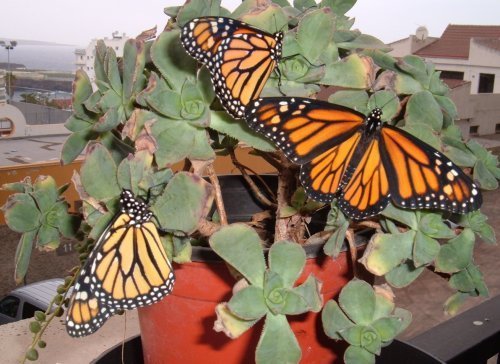
Milkweed
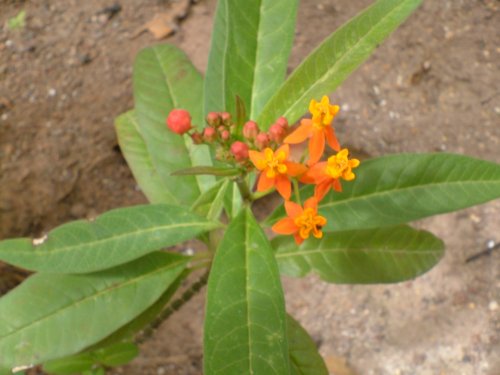
Monarch caterpillars
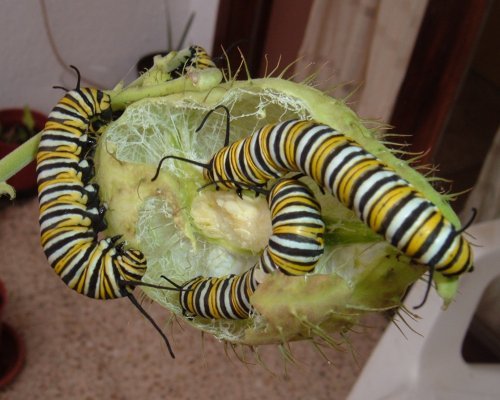
To attract the Monarch Butterfly
Monarch butterflies are those big reddish-orange ones with black-veined wings that swoop and glide over gardens in Tenerife. You can't miss them if there are any about.
The adults are not too fussy about what types of flowers they will sip nectar from but their caterpillars can only eat species in the Milkweed family. On Tenerife this means the Scarlet Milkweed (Asclepias curassavica) , which is also known as Tropical Milkweed and Blood Flower. This pretty flower with red and yellow flowers is easy to grow, though not so easy to find in shops and nurseries that sell plants and seeds. It can be bought here and is sold as Asclepias. An easier way is to order seeds from suppliers on the Internet.
I have managed to rear as many as 50 adult Monarch Butterflies to adulthood in one week after rearing their striped caterpillars on plants I grew in pots on my balcony. So think how many could be reared in a proper garden!
The caterpillars eat a tremendous amount of leaves and will strip your plants but usually they will recover and sprout again. I am happy to report that the English Library in Puerto de la Cruz is going to be growing Milkweed and helping in the conservation of the Monarch Butterfly.
The Monarch caterpillars will also eat the larger Swan Plant (Gomphocarpus fruticosus syn. Ascelpias fruticosa). It will grow well in Tenerife but is seldom seen here. Again seeds are often available from Internet suppliers. This plant has white flowers that turn into inflated seed-pods and it is also known as the Tennis Ball Bush.
Plant any species of Asclepias and you can expect to have Monarchs laying their eggs on these plants in your garden.
In Gran Canaria the related Calotropis procera, has become naturalised and is a member of the Asclepiadaceae . It has various common names including Rubber Bush, Calotrope, and Sodom's Apple. It has inflated seed-pods like the Swan Plant and is also a food source for the Monarch Butterfly caterpillar and for that of the next species.
The African Monarch (D. chrysippus) is closely related to the Monarch and also found in Tenerife, though is far less frequently seen. I have only seen one in eight years and that was in a garden in Santa Ursula where Scarlet Milkweed was growing and which had obviously attracted it.
At that point in time there was a flower border outside the town hall there that was planted with Milkweed and the same plants growing outside a florist's over the road. I counted as many as 10 butterflies flying in a short stretch of the main street there and I dubbed Santa Ursula as "Tenerife's top town for butterflies".
African Migrant butterfly
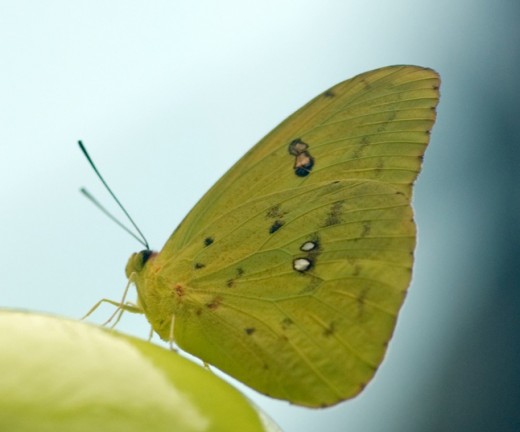
Senna
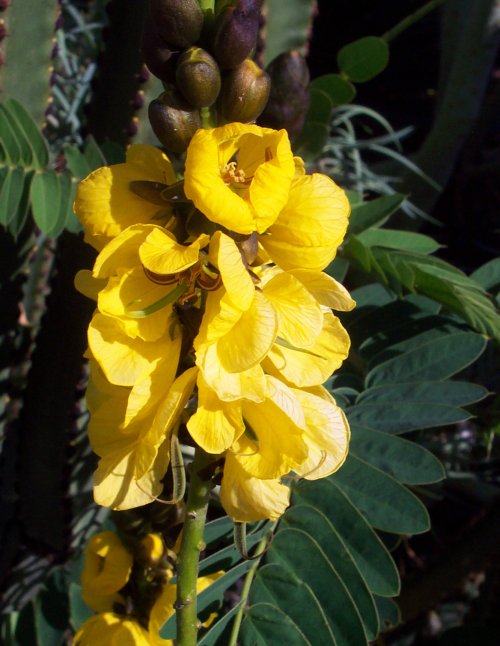
The African Migrant
The African Migrant (Catopsilia florella) is another butterfly that has been able to colonise the Canary Islands due to plants that have been planted there. This was the case too with the Monarch because none of the Milkweed species are native to the islands.
Both these species have actually taken advantage of what humans have done which makes a change when you consider how many animals and plants have suffered because of what people do.
The African Migrant's caterpillar feeds on Senna (Cassia species), of which there are two types cultivated in Tenerife for their pretty yellow flowers and attractive foliage. Both C. spectabilis and C. didymobotrya are often grown in ornamental shrub borders in parks and gardens and this has allowed the African Migrant to make its home on the islands too.
It is a large and fast-flying butterfly with yellow wings in the male and creamy white in the female. The African Migrant is often seen flying in resort areas where the ornamental bushes it depends on are grown.
The adult butterflies also like to feed from flowers on shrubs and trees in gardens and parks in these places but most of the time they don't stop and are hard to get a close look at.
This butterfly has so far been found in Tenerife and Gran Canaria but comes originally from Africa as its name suggests. The African Migrant is a member of the Pieridae, which is the family that also includes the white butterflies which will be also discussed later on.
Bard of Ely talks about the African Migrant butterfly and the Senna
African Grass Blue
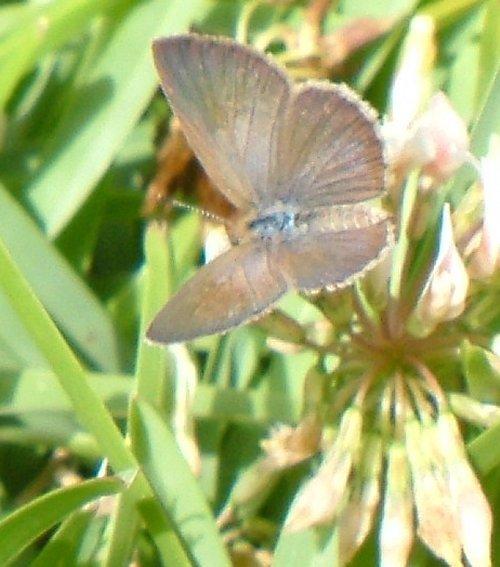
African Grass Blue
The African Grass Blue (Zizeera knysna) is a small butterfly that like the African Migrant is often seen in populated areas and tourist resorts. It has also benefited from human activity and is frequently to be spotted flying around flower beds and over lawns.
Its caterpillars have a wide range of food-plants but one of these is the White Clover (Trifolium repens) that often grows as a weed in hotel and other public lawns. I have seen a patch of this plant growing in grass by a pathway in a shopping centre in Los Cristianos with several of these little butterflies flitting about.
The caterpillars also feed on other species of clover and trefoils and are reported to eat some types of Oxalis too, of which there are several on Tenerife.
The African Grass Blue doesn't mind if the lawns are watered on a regular basis or the continual activity of people close to where they live. If you wish to attract this butterfly make sure you leave plenty of clover growing in a lawn if you have one in your garden.
Canary Island Red Admiral
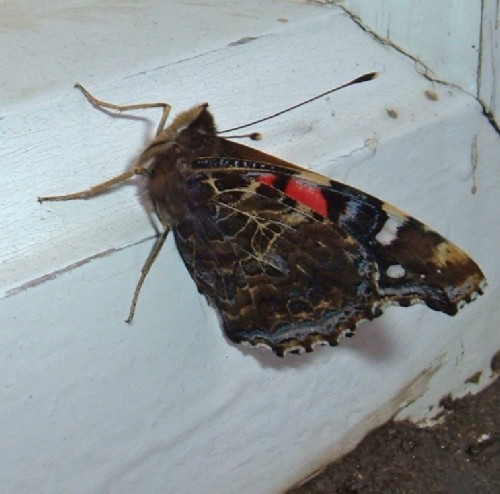
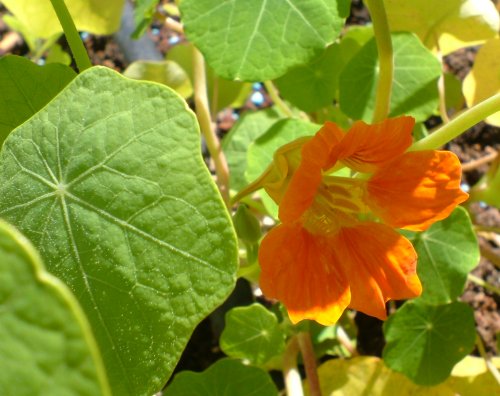
Canary Island Large White
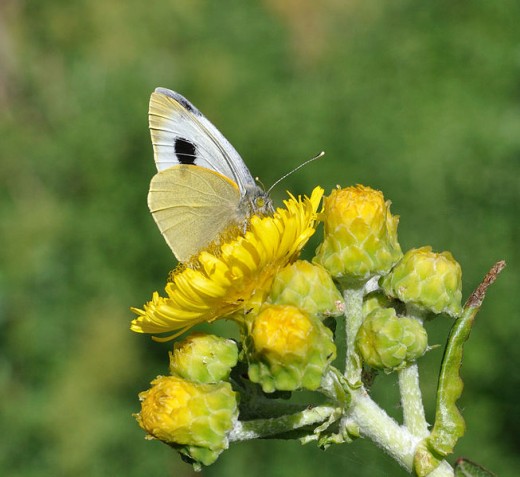
Small White
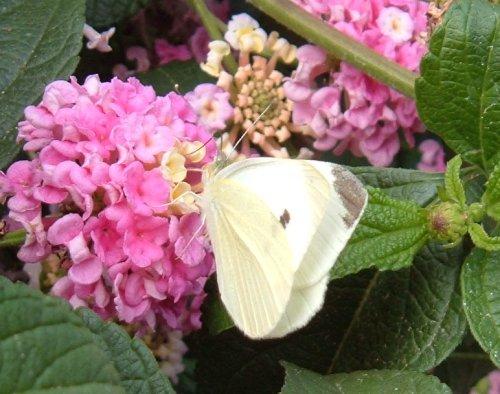
Other Tenerife butterflies
Other Tenerife butterflies you might be able to attract include the Canarian Red Admiral (Vanessa vulcanorum), especially if you are in the north of the island where this species tends to live. It looks like a smaller version of the better known Red Admiral (V. atalanta) that is often seen in the UK in late summer and early autumn.
Both types of Red Admiral need Nettle (Urtica) species for their caterpillars to eat. U. morifolia is a perennial endemic species that tends to be found in areas where there are laurel forests. There is also the annual Nettles known to botanists as U. stachyoides and U. urens as well as the well-known Stinging Nettle (U.dioica).
If you have any species of Nettle growing in your garden and you want to encourage Red Admirals then the advice is to let them grow.
The Painted Lady (Cynthia cardui) is a widely distributed migratory butterfly that is quite common on Tenerife. Its caterpillars have a very wide range of food-plants and includes nearly all types of Thistle, as well as species in the Mallow family (Malvaceae).
The Canary Island Speckled Wood (Parage xiphioides) is a common brown butterfly with its wings speckled with lighter yellowish or orange-brown. It likes cooler and shady areas and again is usually seen in the north of the island. Its caterpillars feed on many species of grass, so if this species lives where you are and you want to encourage it leave a wild patch of long grass somewhere in your garden.
The Canary Islands Large White (Pieris cheiranthi) is actually threatened by loss of its natural habitat which is woodland and is listed as vulnerable so you are not likely to see it but if you do and can help this butterfly then you are doing some important conservation work. This species is very like the Large White (P. brassicae) that is well-known to British gardeners, although it has much darker colouration.
Besides all types of cabbage family (Brassica) plants, the caterpillars will also eat various species from the Cress family (Cruciferae) and the Nasturtium (Tropaeolum majus).
You are far more likely to see the Small White (P. rapae) and its caterpillars feed on the same `plants as its much larger and rarer relative. Grow Nasturtiums and you are likely to give it's a home for its caterpillars.
All sorts of garden flowers will attract adult butterflies and the commonly grown shrub known as Lantana (Lantana camara) with its red and yellow flowers is a firm favourite.
Death's Head Hawk
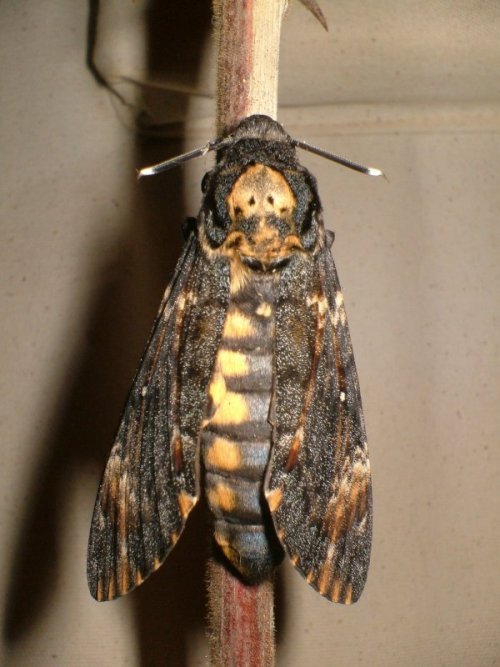
Death's Head Hawk caterpillar
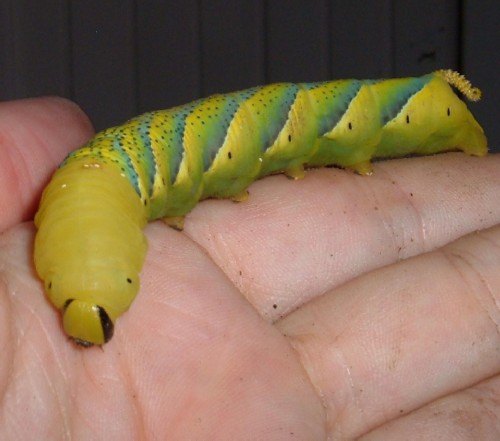
Hawk Moths
There are some very large and interesting hawk moths in Tenerife, including the Silver-striped Hawk Moth or Vine hawk Moth (Hippotion celerio), the White-lined Sphynx or Striped Hawk Moth (Hyles lineata), the Hummingbird Hawk Moth (Macroglosum stellatarum) and the massive Death's Head Hawk Moth (Acherontia atropos).
The first two of these species have caterpillars that eat a number of food-plants including Grape vines. The larvae have characteristic horns on their tails as do all species in the hawk moth family.
The moths fly at night and will visit all sorts of flowers and particularly like Tobacco Plants (Nicotiana species) and other blooms with a tubular form. They have long tongues to probe deep in search of nectar.
The Hummingbird Hawk Moth is smaller and flies by day in bright sunlight. It really does look like the bird it is named after as it hovers in front of flowers it is feeding from and it has a fat furry body. Its caterpillar feeds on several food-plants and this moth is often seen in the south as well as the north of the island.
The most impressive of all though is the huge Death Head's Hawk Moth. It has a curious skull-like marking on its thorax and the stripes across its body look like the ribs of a skeleton. Besides its weird appearance that has made it the subject of many superstitions this moth can squeak.
The Death's Head Hawk Moth is unable to feed from flowers because its proboscis is too short. Instead it feeds on tree sap and on honey which it steals from beehives. It has an equally massive caterpillar that comes in a green, yellow or brown form.
The Death's Head Hawk Moth caterpillar is almost spoiled for choice with plants and trees it can eat in Tenerife. It will feed on Potato, which is a popular crop on the island, and many other species in the Nightshade family or Solanaceae, including Thorn Apple (Datura stramonium), as well as the Lantana in the Verbenaceae, which I have already mentioned as a good flowering shrub to attract butterflies. The caterpillar can also be found on species in the Bignoniaceae, of which there are several strubs and climbers in this group that are grown on Tenerife, and on the Tulip Tree (Spathodea campanulata).
If you see any very large moths feeding from flowers at night or find any very large caterpillars with spiky horns on their tail-ends they will be some species of hawk moth for sure. A good variety of flowering plants is likely to help attract these interesting insects.
Copyright © 2012 Steve Andrews. All Rights Reserved.

